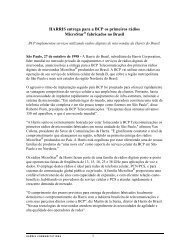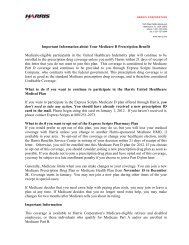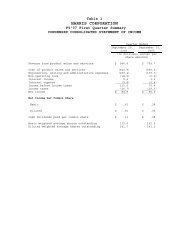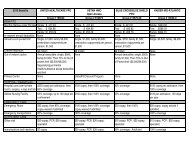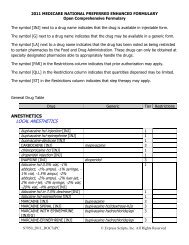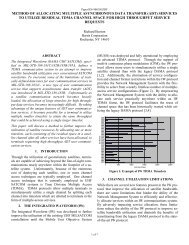harris corporation
harris corporation
harris corporation
Create successful ePaper yourself
Turn your PDF publications into a flip-book with our unique Google optimized e-Paper software.
We have made, and may continue to make, strategic acquisitions that involve significant risks and uncertainties.<br />
We have made, and we may continue to make, strategic acquisitions that involve significant risks and<br />
uncertainties. These risks and uncertainties include:<br />
• Difficulty in identifying and evaluating potential acquisitions, including the risk that our due diligence does<br />
not identify or fully assess valuation issues, potential liabilities or other acquisition risks;<br />
• Difficulty in integrating newly acquired businesses and operations, including combining product and service<br />
offerings, and in entering into new markets in which we are not experienced, in an efficient and cost-effective<br />
manner while maintaining adequate standards, controls and procedures, and the risk that we encounter<br />
significant unanticipated costs or other problems associated with integration;<br />
• Difficulty in consolidating and rationalizing IT infrastructure, which may include multiple legacy systems<br />
from various acquisitions and integrating software code;<br />
• Challenges in achieving strategic objectives, cost savings and other benefits expected from acquisitions;<br />
• Risk that our markets do not evolve as anticipated and that the strategic acquisitions do not prove to be those<br />
needed to be successful in those markets;<br />
• Risk that we assume significant liabilities that exceed the limitations of any applicable indemnification<br />
provisions or the financial resources of any indemnifying parties;<br />
• Potential loss of key employees or customers of the acquired businesses; and<br />
• Risk of diverting the attention of senior management from our existing operations.<br />
Disputes with our subcontractors and the inability of our subcontractors to perform, or our key suppliers to<br />
timely deliver our components, parts or services, could cause our products or services to be produced or delivered<br />
in an untimely or unsatisfactory manner.<br />
On many of our contracts, we engage subcontractors. We may have disputes with our subcontractors, including<br />
disputes regarding the quality and timeliness of work performed by the subcontractor, customer concerns about the<br />
subcontract, our failure to extend existing task orders or issue new task orders under a subcontract, our hiring of the<br />
personnel of a subcontractor or vice versa or the subcontractor’s failure to comply with applicable law. In addition,<br />
there are certain parts, components and services for many of our products and services which we source from other<br />
manufacturers or vendors. Some of our suppliers, from time to time, experience financial and operational<br />
difficulties, which may impact their ability to supply the materials, components, subsystems and services that we<br />
require. Any inability to develop alternative sources of supply on a cost-effective and timely basis could materially<br />
impair our ability to manufacture and deliver products and services to our customers. We can give no assurances<br />
that we will be free from disputes with our subcontractors, material supply problems or component, subsystems or<br />
services problems in the future. Also, our subcontractors and other suppliers may not be able to acquire or maintain<br />
the quality of the materials, components, subsystems and services they supply, which might result in greater product<br />
returns, service problems and warranty claims and could harm our business, financial condition and results of<br />
operations.<br />
Third parties have claimed in the past and may claim in the future that we are infringing directly or indirectly<br />
upon their intellectual property rights, and third parties may infringe upon our intellectual property rights.<br />
Many of the markets we serve are characterized by vigorous protection and pursuit of intellectual property<br />
rights, which often has resulted in protracted and expensive litigation. Third parties have claimed in the past and<br />
may claim in the future that we are infringing directly or indirectly upon their intellectual property rights, and we<br />
may be found to be infringing or to have infringed directly or indirectly upon those intellectual property rights.<br />
Claims of intellectual property infringement might also require us to enter into costly royalty or license agreements.<br />
Moreover, we may not be able to obtain royalty or license agreements on terms acceptable to us, or at all. We also<br />
may be subject to significant damages or injunctions against development and sale of certain of our products,<br />
services and solutions. Our success depends in large part on our proprietary technology. We rely on a combination<br />
of patents, copyrights, trademarks, trade secrets, know-how, confidentiality provisions and licensing arrangements to<br />
establish and protect our intellectual property rights. If we fail to successfully protect and enforce these rights, our<br />
competitive position could suffer. Our pending patent and trademark registration applications may not be allowed, or<br />
competitors may challenge the validity or scope of our patents or trademark registrations. In addition, our patents<br />
may not provide us a significant competitive advantage. We may be required to spend significant resources to<br />
monitor and police our intellectual property rights. We may not be able to detect infringement and our competitive<br />
position may be harmed before we do so. In addition, competitors may design around our technology or develop<br />
competing technologies.<br />
23




